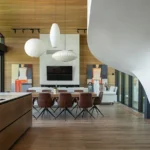
ARCHISCENE Magazine editor Katarina Djoric sits down with Marija Hadji Pecova to discuss the creative process behind the Duality Collection, a furniture line that challenges traditional boundaries by juxtaposing contrasting elements. Inspired by the concept of dualism, light and dark, soft and hard, the collection reflects the complexities of human experience. The concept originated from the designer’s reflections on dualities in life, inspiring her to express these contrasts through the use of color, materials, and emotions in her work.
Key pieces like the Duality Chair showcase this philosophy. Designed with bold royal blue and acidic green tones, the chair captures power and vibrancy, while its sculptural form balances aesthetics with function. The process began with sketches on her phone, which she developed further by incorporating visual and tactile contrasts, using raw steel and soft textiles to convey the theme. The Duality Collection, with its striking forms and thoughtful details, invites users to see furniture as more than utility, it becomes an artistic centerpiece that transforms any space into a conversation.

Your Duality Collection explores the concept of dualism—contrasting colors, materials, and emotions. How did you first develop this idea, and what inspired you to translate it into furniture design?
Few months ago I was reading a book that explores the dual nature of the world and I started thinking how we experience the dualities in all possible ways in our life. Good and bad, bitter and sweet, dark and light, summer and winter are all polarities that exist in the universe and within ourselves. And I wanted to continue exploring this concept in my creative work, creating furniture collection that represents the concept of dualism as a contrast between two colors, two materials and two emotions.
The interplay between royal blue and acidic green is central to the collection’s emotional impact. Why did you choose these particular colors, and how do they shape the mood of a space?
I have always been fascinated by color and emotions. Like how does wearing a certain color makes me feel, or how a colourful space impacts my experience in it so I try to analyse and follow these emotions that have been evoked. The amalgamation of colors chosen for this collection are the primary and dominant royal blue which symbolizes power, calmness and elegance, and the secondary acidic green which symbolizes harmony and peace. The royal blue color is authoritative, it catches glimpses and has a bold statement in space while the acidic green radiates liveliness and playfulness. The collection is created to revive the space and to catch attention.
The Duality Chair stands out with its bold design and dichromatic elements. Can you talk us through its creation process and how you balanced its sculptural form with functionality?
The creation of the chair as the first design of the entire collection began as a digital sketches drawn on my iPhone in the color that I am currently obsessed with. For a long time that is Royal Blue and I indulge myself in it, I wear full monochromatic blue outfits, I use blue color in my projects and I use every day blue objects. I design with my heart, I first envision the form and then it just transforms itself into a chair. After that I use my professional skills to bring function to the chair without compromising the visual aesthetic.

Your pieces feature raw materials like steel with natural patinas, alongside soft textiles and lacquered finishes. How do you see this juxtaposition reflecting the theme of duality?
I like playing with contrast, blending light and dark, old and new, traditional and modern so I used this principle to create juxtaposition between materials and surfaces to achieve tactile and visual appeal. The texture of the materials, used in the collection both soft and hard impose the overall visual aesthetic and are repeated as design codes in the collection and interact with the surroundings utilizing the theme of duality.
The Duality Bench pays homage to traditional seating elements while offering a contemporary sculptural interpretation. How important is cultural memory to your design process?
In my design process I spend a lot of time researching and finding inspiration particularly throughout history because everything is already invented so I want to see how the masters did it in the past. I am often influenced by traditional designs that are characterized with simplicity and I try to translate them into contemporary designs and give them a modern twist. It’s quite interesting to see how furniture is evolving through history in style, material and form but the function always remain the same.

As both an architect and designer, how does your architectural background influence the way you approach furniture design, particularly with sculptural pieces like these?
Architecture and furniture design are very similar because they both require an idea to be materialized from a sketch into reality and they both involve executing a vision only the architect or designer can see. That vision can be seen only after the project is completed and that is the beauty of being an architect. Coming from an architectural background, I understand the construction aspect of furniture design and how to utilize norms and principles to translate my vision into my designs.
You mentioned wanting to provoke emotions and transform atmospheres through design. How do you envision the Duality Collection functioning in different interiors?
The Duality Collection has a bold expressive shape elevating it beyond mere functionality to became a statement piece within a space. The collection consists of five design pieces that are created to be complimentary to each other or the opposite, one of them individually to carry the aesthetic of the whole collection. I envisioned them being placed in a neutral space, something like a blank canvas so they can radiate and light up the room. They are meant to be a focal point in interior spaces, inviting admiration and sparking conversation.

Where do you draw the line between functional furniture and artistic expression, or do you see them as inherently interconnected?
Functional furniture is primarily concerned with functionality and comfort while sculptural furniture essentially refers to furniture pieces that incorporate artistic expression in their design. I like blurring the lines between design and art and creating furniture pieces that serve as an artistic statement, adding character, individuality and visual interest.
How do you approach finding harmony between clean architectural lines and organic silhouettes in your projects?
I like to approach every project with a bit of individuality, and for me that is breaking the rigid and angular plans that may dominate a space with the use of curved lines, organic shapes and soft textures. I like to use organic silhouettes to bring dynamic movement into space, to make something that is unexpected. The organic shapes mimic those found in nature, and they add an element of visual interest with a touch of extraordinary.


As this is your first furniture collection, what challenges did you face during its creation, and what do you hope people will take away from experiencing the Duality Collection?
I didn’t have any particular challenges while creating this collection, from the very beginning of this creative journey I was focused on following my vision. I wanted my initial idea to turn into reality exactly like It was on the first sketches. And I am quite satisfied with the end result. I hope that when people see my designs they will make them feel something. After all, why everyday objects should be boring and ordinary? What we see, use or are surrounded with should be everything but ordinary. Let’s change ordinary with extraordinary.




